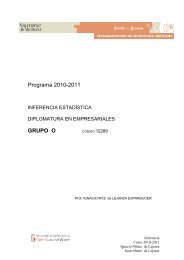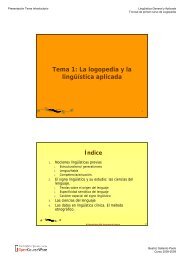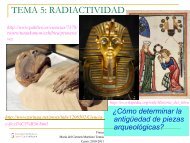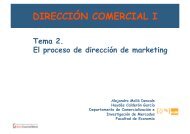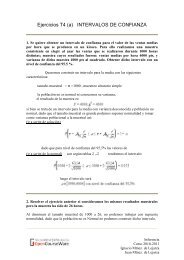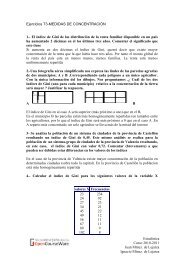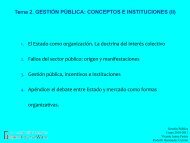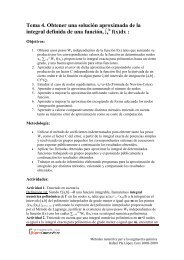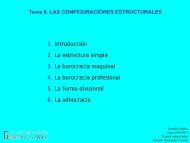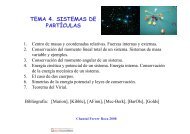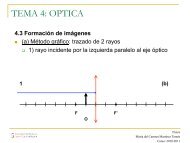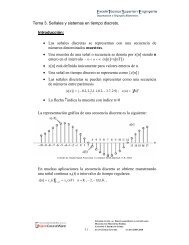Act of utterance and the utterance, act of utterance - OCW de la ...
Act of utterance and the utterance, act of utterance - OCW de la ...
Act of utterance and the utterance, act of utterance - OCW de la ...
- No tags were found...
You also want an ePaper? Increase the reach of your titles
YUMPU automatically turns print PDFs into web optimized ePapers that Google loves.
05.02. Enunciative analysis <strong>of</strong> impaired speech samples: speech <strong>act</strong>s - 99The study by Soroker et al. (2005) <strong>de</strong>fends a direct association between certain left-hemisphere(LH) locations (those <strong>of</strong> BSA), arguing that <strong>the</strong> right hemisphere (RH) only takes partoccasionally in some cases <strong>of</strong> requests. It should be pointed out, however, that <strong>the</strong>y are notstrictly speaking about illocutiveness (<strong>of</strong> pragmatics) but about <strong>the</strong> morphosyntaxis <strong>and</strong>semantics required to carry out this communicative intent. As no item <strong>of</strong> those used is<strong>de</strong>scribed, we cannot know ex<strong>act</strong>ly what relevance <strong>the</strong> results have.In any case, <strong>the</strong> final statement that “<strong>the</strong>re is systematic localization <strong>of</strong> BSAs in <strong>the</strong> LH but not in <strong>the</strong>RH” should be taken in a re<strong>la</strong>tive sense, to <strong>the</strong> extent that <strong>the</strong> items assessed (basic illocutionary<strong>act</strong>s) <strong>de</strong>pend on semantics <strong>and</strong> morphosyntaxis for <strong>the</strong>ir execution, toge<strong>the</strong>r with <strong>the</strong> f<strong>act</strong> that<strong>the</strong> speakers assessed use <strong>the</strong> grammar <strong>of</strong> a specific <strong>la</strong>nguage. The methodological <strong>de</strong>scriptionfor <strong>the</strong> study does not say explicitly 12 , but we can <strong>de</strong>duce that it <strong>de</strong>als with Hebrew speakersbecause it is stated that <strong>the</strong> subjects (21 with right hemisphere injury <strong>and</strong> 31 with lef<strong>the</strong>misphere injury) were assessed using Hebrew versions <strong>of</strong> <strong>the</strong> Western Battery (Kertesz) <strong>and</strong><strong>of</strong> <strong>the</strong> Grammatical Comprehension Test (Curtiss). These are, <strong>the</strong>n, speakers <strong>of</strong> a non-tonal,fusioning <strong>la</strong>nguage, with a word or<strong>de</strong>r that is not particu<strong>la</strong>rly markedly Verb-Subject-Objectbut quite flexible, <strong>and</strong> in which <strong>the</strong>re is a notable use <strong>of</strong> triliteral roots typical <strong>of</strong> Semitic<strong>la</strong>nguages, using concatenated morphemes (ad<strong>de</strong>d) but also with segmental changes (a change<strong>of</strong> vowels in some verbal forms can lead to morphological change). It can be said that <strong>the</strong> brains<strong>of</strong> speakers <strong>of</strong> tonal <strong>la</strong>nguages (both iso<strong>la</strong>ting <strong>and</strong> fusioning, that is with lexical ormorphological use <strong>of</strong> <strong>the</strong> tonal change) can show o<strong>the</strong>r uses <strong>of</strong> <strong>the</strong>ir respective hemispheres...* * * *In short, when analysing <strong>the</strong> enunciative dimension <strong>of</strong> speech <strong>act</strong>s in data from impairedspeakers, we will be analysing <strong>the</strong> following categories:• PROPOSITIONAL ACTS [AP]: that is, those <strong>act</strong>s that possess a semantic load based on<strong>the</strong> lexicon <strong>of</strong> <strong>the</strong> <strong>la</strong>nguage <strong>and</strong> thus informatively progress <strong>the</strong> conversation; <strong>of</strong>course, this lexicon can be impaired, with symptoms such as agrammatism orparagrammatism, but it responds to <strong>the</strong> habitual use <strong>of</strong> natural <strong>la</strong>nguages. This type<strong>of</strong> speech <strong>act</strong> sometimes involves a minimal semantic content, which approaches<strong>the</strong> category that Tomoeda <strong>and</strong> Bayles (1993) 13 i<strong>de</strong>ntify as “information units” for<strong>the</strong> speech <strong>of</strong> subjects with Alzheimer.• INFERENCE ACTIVATING ACTS: <strong>the</strong>se types <strong>of</strong> speech <strong>act</strong> are particu<strong>la</strong>rly frequent inmotor aphasias, but <strong>the</strong>y also appear in <strong>de</strong>mentias, as <strong>the</strong> speaker uses <strong>the</strong>m toexploit <strong>the</strong> inferential ability <strong>of</strong> <strong>the</strong>ir conversational partner <strong>and</strong> achieves acol<strong>la</strong>borative construction <strong>of</strong> <strong>the</strong> inter<strong>act</strong>ion. They are frequently monolexematic,present leng<strong>the</strong>nings <strong>and</strong> suspen<strong>de</strong>d intonation <strong>and</strong> are usually accompanied byillustrators or regu<strong>la</strong>tors;- INTERJECTION [Int.]: <strong>the</strong>se are exc<strong>la</strong>mations that can have a variablelexicalised semantic content; as we know, <strong>the</strong> interjection is pragmatically12 This use a generalist discourse that does not give relevance to <strong>the</strong> features commented upon here: nor to<strong>the</strong> necessary use <strong>of</strong> grammar for pragmatic ends, nor to it subjects' specific <strong>la</strong>nguage. These authors, fromTel-Aviv University, are used to working with English <strong>and</strong>/or Hebrew speakers (<strong>the</strong>ir interestingPragmatic Battery, from 1999, prepares it in both <strong>la</strong>nguages; <strong>the</strong>y have also adapted <strong>the</strong> RHCB: RightHemisphere Communication Battery, by Howard Gardner <strong>and</strong> Hiram H. Brownell, 1986, into Hebrew), <strong>and</strong>so this simplification is ra<strong>the</strong>r surprising.13 Tomoeda C.K., Bayles K.A. (1993). Longitudinal effects <strong>of</strong> Alzheimer’s disease on discourse production.Alzheimer Disease <strong>and</strong> Associated Disor<strong>de</strong>rs 4: 223-236.Linguistic Analysis <strong>of</strong> Speech Language Disor<strong>de</strong>rsBeatriz Gal<strong>la</strong>rdo Paúls. Course 2008-2009.



